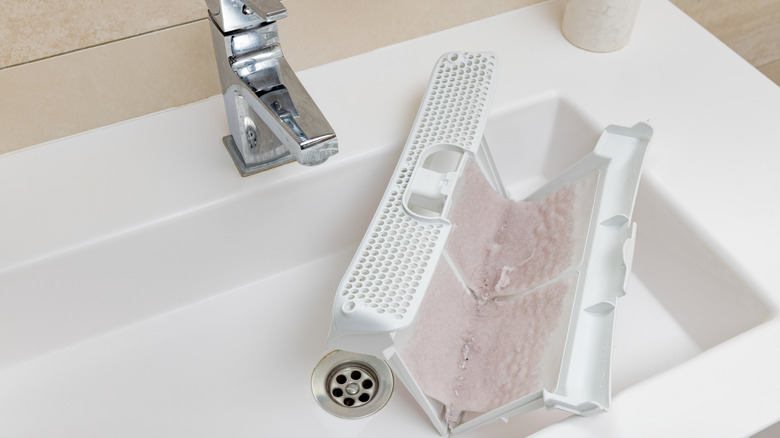The One Part Of Your Dryer You've Never Thought To Wash
Unless you've been lucky enough to avoid ever doing laundry, you probably learned at some point to clean the lint trap every time you dry a load. Taking the screen out and peeling the debris into the trash is an easy step to incorporate into your routine. But if you've never thought to actually wash the lint trap — with soap and water — you may still not be doing enough.
Keeping the trap clean, as opposed to simply free of large lint chunks, is important for several reasons. First, dryers cause thousands of house fires each year. Many of those fires start due to a failure to clean, and it's often the lint that's the culprit. The lint trap is your frontline defense against lint buildup in the back of the dryer and the venting system. Also, when the screen is clogged by lint fibers, it blocks hot, moist air from escaping and lengthens the time your laundry takes to dry.
Even if your dryer is fairly new and you meticulously clean your lint trap each time you use it, you might still be better off washing the screen now and then. Fabric softeners and detergents can leave some residue on it, and this gunk creates tiny blockages that also impede air flow. An occasional thorough wash is essential for your safety and dryer performance.
How to deep clean a lint trap
You should inspect and deep clean your lint trap at least every six months (or sooner if you notice residue or debris). First, follow your normal protocol to remove the lint from the screen with your hands. If you need to, use the vacuum cleaner crevice attachment to remove stubborn bits from the corners. Then wash the screen with warm water and dish soap, scrubbing both sides of it gently with a brush. Finally, use the crevice tool to vacuum the lint trap opening in the dryer. If you can access it, go ahead and clean your dryer vent while you're at it.
You can gauge how clean the screen has gotten by seeing how easily water passes through it. If there's a lot of residue, you may need to soak the screen for 30 minutes and scrub again or try stain-busting ingredients like baking soda and vinegar. When the screen is perfectly clear, rinse and dry it thoroughly with a cloth before inserting it back into your dryer. Don't forget to regularly and clean the dryer drum — lint can accumulate in this part, and it's just not worth the risk.

